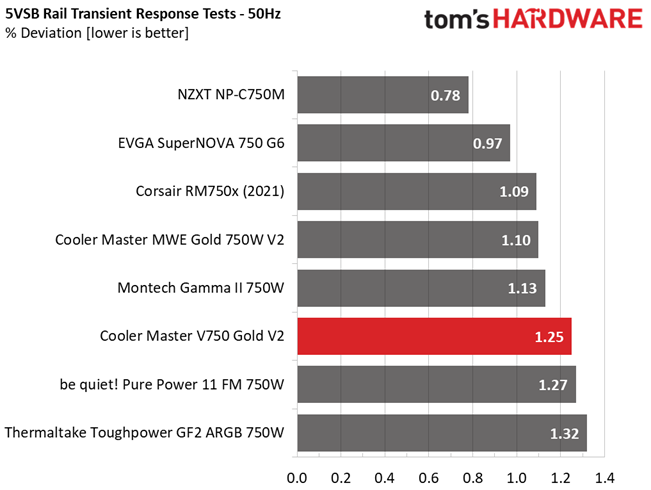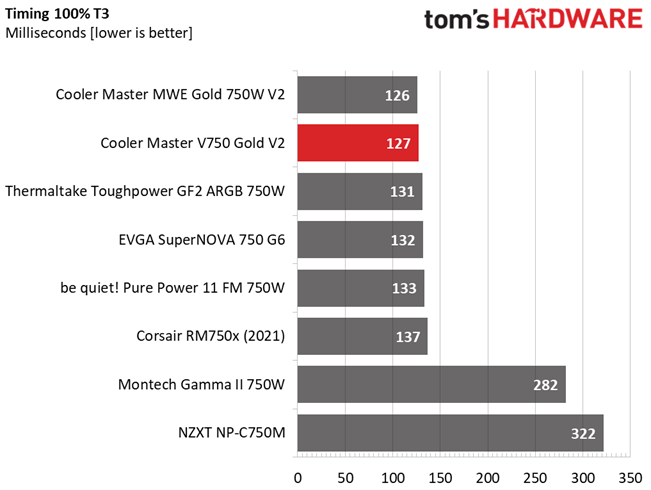Why you can trust Tom's Hardware
Advanced Transient Response Tests
For details about our transient response testing, please click here.
In the real world, power supplies are always working with loads that change. It's of immense importance, then, for a PSU to keep its rails within the ATX specification's defined ranges. The smaller the deviations, the more stable your PC will be and the less stress will be applied to its components.
We should note that the ATX spec requires capacitive loading during the transient rests, but in our methodology, we also choose to apply a worst case scenario with no additional capacitance on the rails.
Advanced Transient Response at 20% – 20ms
| Voltage | Before | After | Change | Pass/Fail |
|---|---|---|---|---|
| 12V | 12.267V | 12.128V | 1.13% | Pass |
| 5V | 5.127V | 5.068V | 1.15% | Pass |
| 3.3V | 3.307V | 3.180V | 3.84% | Pass |
| 5VSB | 4.966V | 4.903V | 1.27% | Pass |
Advanced Transient Response at 20% – 10ms
| Voltage | Before | After | Change | Pass/Fail |
|---|---|---|---|---|
| 12V | 12.266V | 12.131V | 1.10% | Pass |
| 5V | 5.128V | 5.071V | 1.11% | Pass |
| 3.3V | 3.307V | 3.183V | 3.75% | Pass |
| 5VSB | 4.966V | 4.900V | 1.33% | Pass |
Advanced Transient Response at 20% – 1ms
| Voltage | Before | After | Change | Pass/Fail |
|---|---|---|---|---|
| 12V | 12.270V | 12.106V | 1.34% | Pass |
| 5V | 5.128V | 5.047V | 1.58% | Pass |
| 3.3V | 3.307V | 3.197V | 3.33% | Pass |
| 5VSB | 4.966V | 4.914V | 1.05% | Pass |
Advanced Transient Response at 50% – 20ms
| Voltage | Before | After | Change | Pass/Fail |
|---|---|---|---|---|
| 12V | 12.218V | 12.097V | 0.99% | Pass |
| 5V | 5.088V | 5.022V | 1.30% | Pass |
| 3.3V | 3.299V | 3.169V | 3.94% | Pass |
| 5VSB | 4.945V | 4.884V | 1.23% | Pass |
Advanced Transient Response at 50% – 10ms
| Voltage | Before | After | Change | Pass/Fail |
|---|---|---|---|---|
| 12V | 12.223V | 12.099V | 1.01% | Pass |
| 5V | 5.107V | 5.048V | 1.16% | Pass |
| 3.3V | 3.300V | 3.169V | 3.97% | Pass |
| 5VSB | 4.945V | 4.882V | 1.27% | Pass |
| Voltage | Before | After | Change | Pass/Fail |
|---|---|---|---|---|
| 12V | 12.218V | 12.097V | 0.99% | Pass |
| 5V | 5.088V | 5.022V | 1.30% | Pass |
| 3.3V | 3.299V | 3.169V | 3.94% | Pass |
| 5VSB | 4.945V | 4.884V | 1.23% | Pass |
Advanced Transient Response at 50% – 1ms
| Voltage | Before | After | Change | Pass/Fail |
|---|---|---|---|---|
| 12V | 12.225V | 12.103V | 1.00% | Pass |
| 5V | 5.108V | 5.055V | 1.04% | Pass |
| 3.3V | 3.300V | 3.176V | 3.76% | Pass |
| 5VSB | 4.945V | 4.881V | 1.29% | Pass |








Transient response on this PSU is tight at 12V and 5V. While it's good enough at 3.3V, we would like to see a less than 3% deviation in this rail.
Turn-On Transient Tests
In the next set of tests, we measured the PSU's response in simpler transient load scenarios—during its power-on phase. Ideally, we don't want to see any voltage overshoots or spikes since those put a lot of stress on the DC-DC converters of installed components.



The turn-on transient results are perfectly acceptable here. Voltage levels on both rails ramp up smoothly, without any steps, voltage drops, or spikes.
Power Supply Timing Tests
There are several signals generated by a power supply, which need to be within specified (by the ATX spec) ranges. If they are not, there can be compatibility issues with other system parts, especially mainboards. A PSU's Power-on time (T1) has to be lower than 150ms and the PWR_OK delay (T3) has be within 100 to 150ms, so that it can be compatible with the Alternative Sleep Mode.
Get Tom's Hardware's best news and in-depth reviews, straight to your inbox.
| T1 (Power-on time) & T3 (PWR_OK delay) | ||
|---|---|---|
| Load | T1 | T3 |
| 20% | 54ms | 127ms |
| 100% | 54ms | 127ms |

PSU Timing Charts



The Cooler Mast V750 Gold V2's PWR_OK delay is within the 100-150ms region, so the PSU supports the alternative sleep mode recommended by the ATX spec.
Ripple Measurements
Ripple represents the AC fluctuations (periodic) and noise (random) found in a PSU's DC rails. This phenomenon significantly decreases a PSU capacitors' lifespan because it causes them to run hotter. A 10-degree Celsius increase can cut into a cap's useful life by 50%. Ripple also plays an important role in overall system stability, especially when overclocking is involved.
The ripple limits, according to the ATX specification, are 120mV (+12V) and 50mV (5V, 3.3V, and 5VSB).
| Test | 12V | 5V | 3.3V | 5VSB | Pass/Fail |
| 10% Load | 7.3 mV | 5.9 mV | 6.9 mV | 10.8 mV | Pass |
| 20% Load | 10.0 mV | 5.8 mV | 6.4 mV | 5.3 mV | Pass |
| 30% Load | 12.0 mV | 6.8 mV | 7.4 mV | 7.3 mV | Pass |
| 40% Load | 8.2 mV | 6.1 mV | 6.5 mV | 6.8 mV | Pass |
| 50% Load | 8.2 mV | 6.7 mV | 6.9 mV | 6.8 mV | Pass |
| 60% Load | 7.8 mV | 7.1 mV | 7.1 mV | 7.4 mV | Pass |
| 70% Load | 13.3 mV | 8.9 mV | 9.2 mV | 9.2 mV | Pass |
| 80% Load | 9.1 mV | 7.9 mV | 9.4 mV | 8.4 mV | Pass |
| 90% Load | 13.7 mV | 9.3 mV | 11.1 mV | 10.2 mV | Pass |
| 100% Load | 13.9 mV | 10.4 mV | 12.0 mV | 12.8 mV | Pass |
| 110% Load | 14.4 mV | 10.7 mV | 12.2 mV | 12.5 mV | Pass |
| Crossload 1 | 15.1 mV | 8.7 mV | 11.0 mV | 6.1 mV | Pass |
| Crossload 2 | 13.5 mV | 8.7 mV | 9.1 mV | 6.6 mV | Pass |




This PSU's ripple suppression is great on all rails.
Ripple At Full Load




Ripple At 110% Load




Ripple At Cross-Load 1




Ripple At Cross-Load 2




EMC Pre-Compliance Testing – Average & Quasi-Peak EMI Detector Results
Electromagnetic Compatibility (EMC) is the ability of a device to operate properly in its environment without disrupting the proper operation of other nearby devices.
Electromagnetic Interference (EMI) stands for the electromagnetic energy a device emits, and it can cause problems in other nearby devices if too high. For example, it can be the cause of increased static noise in your headphones or/and speakers.
EMI emissions were low with both detectors we used (Average and Peak).
MORE: Best Power Supplies
MORE: How We Test Power Supplies
MORE: All Power Supply Content
Current page: Transient Response Tests, Timing Tests, Ripple Measurements and EMC Pre-Compliance Testing
Prev Page Protection Features, DC Power Sequencing, Cross-Load Tests and Infrared Images Next Page Performance, Noise, Efficiency and Power Factor
Aris Mpitziopoulos is a contributing editor at Tom's Hardware, covering PSUs.
-
helper800 A good Cooler Master branded PSU? Wow good on CM to find a good manufacturer. On a side-note what determines whether a product gets an editor's choice award from Toms? Aris seemed pretty happy with the PSU. Lets hope CM keeps using manufacturers that use modern PSU platforms.Reply -
jayjr1105 Great review. nice to see another OEM with 10 year warranty worthy build quality and parts.Reply
Any plans on doing some of the very affordable Superflower Leadex III units?
